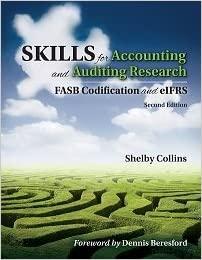Question
1. Which of the following is a characteristic of a perpetual inventory system? a. Inventory purchases are debited to a Purchases account. b. Inventory records
1. Which of the following is a characteristic of a perpetual inventory system? a. Inventory purchases are debited to a Purchases account. b. Inventory records are not kept for every item. c. Cost of goods sold is recorded with each sale. d. Cost of goods sold is determined as the amount of purchases less the change in inventory.
2. How is a significant amount of consignment inventory reported in the statement of financial position? a. The inventory is reported separately on the consignor's statement of financial position. b. The inventory is combined with other inventory on the consignor's statement of financial position. c. The inventory is reported separately on the consignee's statement of financial position. d. The inventory is combined with other inventory on the consignee's statement of financial position.
3. The acquisition cost of a certain raw material changes frequently. The book value of the inventory of this material at year end will be the same if perpetual records are kept as it would be under a periodic inventory method only if the book value is computed under the a. weighted-average method. b. moving average method. c. FIFO method. d. None of these are correct.
4. In a period of rising prices, the inventory method which tends to give the highest reported net income is a. moving-average. b. first-in, first-out. c. weighted-average. d. None of these are correct.
5. Chess Top uses the periodic inventory system. For the current month, the beginning inventory consisted of 200 units that cost 65 each. During the month, the company made two purchases: 300 units at 68 each and 150 units at 70 each. Chess Top also sold 500 units during the month. Using the average cost method, what is the amount of ending inventory? a. 10,500. b. 33,770. c. 33,400. d. 10,131.
6. Chess Top uses the periodic inventory system. For the current month, the beginning inventory consisted of 200 units that cost 65 each. During the month, the company made two purchases: 300 units at 68 each and 150 units at 70 each. Chess Top also sold 500 units during the month. Using the FIFO method, what is the amount of cost of goods sold for the month? a. 33,770. b. 32,500. c. 34,150. d. 33,400.
Use the following information for questions 7 and 8. The following information was available from the inventory records of Rich Company for January: Units Unit Cost Total Cost Balance at January 1 3,000 9.77 29,310 Purchases: January 6 2,000 10.30 20,600 January 26 2,700 10.71 28,917 Sales: January 7 (2,500) January 31 (4,000) Balance at January 31 1,200
7. Assuming that Rich does not maintain perpetual inventory records, what should be the inventory at January 31, using the weighted-average inventory method, rounded to the nearest dollar? a. 12,606. b. 12,284. c. 12,312. d. 12,432.
8. Assuming that Rich maintains perpetual inventory records, what should be the inventory at January 31, using the moving-average inventory method, rounded to the nearest dollar? a. 12,606. b. 12,284. c. 12,312. d. 12,432.
Step by Step Solution
There are 3 Steps involved in it
Step: 1

Get Instant Access to Expert-Tailored Solutions
See step-by-step solutions with expert insights and AI powered tools for academic success
Step: 2

Step: 3

Ace Your Homework with AI
Get the answers you need in no time with our AI-driven, step-by-step assistance
Get Started


